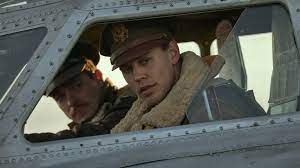In the climactic finale of Apple TV+’s “Masters of the Air,” viewers were left captivated by a surreal and symbolic moment involving protagonist Gale “Buck” Cleven and a wounded white horse. As Buck, portrayed by Austin Butler, witnesses the horse trailing retreating German soldiers with blood smeared on its side but no visible wounds, the scene resonates with deeper meaning, serving as a visual metaphor for Buck’s own journey of survival and resilience amidst the chaos of war.
Executive producer Gary Goetzman sheds light on the symbolism behind this poignant encounter, explaining that the white horse represents more than just a fleeting image—it embodies Buck’s inner turmoil and the pivotal crossroads he finds himself at. Buck, having escaped captivity but still confronting the harrowing realities of war, is akin to the champion horse, both wondering about their respective paths and destinies.
Throughout the series, Buck’s character endures a series of trials and tribulations that test his strength and resilience. From being shot down to enduring captivity under the Nazis, his journey is fraught with danger and uncertainty. However, his friendship with Bucky Egan, portrayed by Callum Turner, serves as a beacon of hope and camaraderie amidst the chaos of battle, highlighting the importance of human connection in times of adversity.
The appearance of the white horse midway through the finale serves as a pivotal moment in Buck’s narrative arc. While it may initially be interpreted as a sign of hope and survival, Goetzman emphasizes that Buck’s journey is far from over. The horse’s bloodied yet unbroken state mirrors Buck’s own struggles—despite the scars and traumas he carries, he emerges as a champion, resilient and determined to forge his own path forward.
As Buck grapples with the aftermath of war and the uncertainties of the future, the white horse becomes a powerful symbol of resilience and endurance. Like the horse, Buck is battered and bruised by his experiences, yet he refuses to be defeated. His survival alongside Bucky and other comrades serves as a testament to the strength of the human spirit in the face of adversity.
FAQ
What does the white horse symbolize in the finale of “Masters of the Air”?
The white horse serves as a visual metaphor for protagonist Buck Cleven’s journey of survival and resilience amidst the chaos of war. It represents Buck’s inner turmoil and the pivotal crossroads he finds himself at, mirroring his struggles and determination to forge his own path forward.
Why is Buck’s encounter with the white horse significant?
Buck’s encounter with the white horse midway through the finale marks a pivotal moment in his narrative arc. It serves as a reflection of his inner struggles and resilience, highlighting his determination to overcome the challenges he faces and emerge as a champion despite the scars and traumas he carries.
What role does Buck’s friendship with Bucky Egan play in the series?
Buck’s friendship with Bucky Egan serves as a beacon of hope and camaraderie amidst the chaos of battle. Their bond highlights the importance of human connection in times of adversity and provides a source of strength and support for both characters throughout their journey in “Masters of the Air.”
